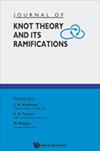jones多项式的导数检测虚拟结中的delta移动
IF 0.3
4区 数学
Q4 MATHEMATICS
引用次数: 0
摘要
对于经典结,∆-移动和交叉变化都可以解开任何结。但许多虚拟的结无法通过这些动作解开。此外,有许多虚拟结可以通过交叉变化解开,但不能通过∆-移动解开。我们证明了琼斯多项式的导数可以检测出一个虚拟结是否可以通过∆-移动来解开。本文章由计算机程序翻译,如有差异,请以英文原文为准。
Derivatives of jones polynomials detect delta moves in virtual knots
For classical knots, ∆-moves and crossing changes can both unknot any knot. But many virtual knots cannot be unknotted with these moves. Moreover, there are many virtual knots that can be unknotted by crossing changes but cannot be unknotted by ∆-moves. We show that the derivative of the Jones polynomial can detect whether a virtual knot can be unknotted by ∆-moves.
求助全文
通过发布文献求助,成功后即可免费获取论文全文。
去求助
来源期刊
CiteScore
0.80
自引率
40.00%
发文量
127
审稿时长
4-8 weeks
期刊介绍:
This Journal is intended as a forum for new developments in knot theory, particularly developments that create connections between knot theory and other aspects of mathematics and natural science. Our stance is interdisciplinary due to the nature of the subject. Knot theory as a core mathematical discipline is subject to many forms of generalization (virtual knots and links, higher-dimensional knots, knots and links in other manifolds, non-spherical knots, recursive systems analogous to knotting). Knots live in a wider mathematical framework (classification of three and higher dimensional manifolds, statistical mechanics and quantum theory, quantum groups, combinatorics of Gauss codes, combinatorics, algorithms and computational complexity, category theory and categorification of topological and algebraic structures, algebraic topology, topological quantum field theories).
Papers that will be published include:
-new research in the theory of knots and links, and their applications;
-new research in related fields;
-tutorial and review papers.
With this Journal, we hope to serve well researchers in knot theory and related areas of topology, researchers using knot theory in their work, and scientists interested in becoming informed about current work in the theory of knots and its ramifications.

 求助内容:
求助内容: 应助结果提醒方式:
应助结果提醒方式:


